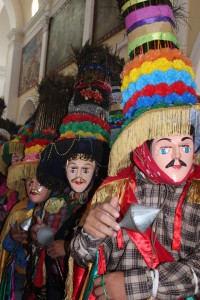 When it comes to cultural events and spiritual uplift, I love church and I love dancing. But you just don’t often get to do the two together. Except in Diriamba, Nicaragua, where I just attended the Reese’s Peanut Butter cup of community events, the last day of the festival for the patron saint of Diriamba (the ever-expressive San Sebastian) and those of several neighboring towns.
When it comes to cultural events and spiritual uplift, I love church and I love dancing. But you just don’t often get to do the two together. Except in Diriamba, Nicaragua, where I just attended the Reese’s Peanut Butter cup of community events, the last day of the festival for the patron saint of Diriamba (the ever-expressive San Sebastian) and those of several neighboring towns.
As is so often the case, this religious event is inextricably bound up with a celebration that has roots in local indigenous tradition. It’s the day when the church is visited by several special patron saints, but the service is also frequented by characters from the Güegüense, a dance/play which is sort of the bedrock of Nicaraguan folklore, as important as the Eddas are for the Finns. Written by an anonymous artist in the 18th century, the Güegüense has it all: marriage, deception, mockery, and not one but two umlauts! Everyone is pretty sure that it was originally composed in Nahuatl (hence the umlauts) and passed on orally (like the Odyssey, the Iliad, and most epic poems and folk songs) until it was written down in the 1940s. The characters are the local folk (you will know them by their black mustaches), particularly an old man named El Güegüense (which means, the old man) and his two sons; then, Spaniards (blonde moustaches) including the local governor; three ladies; and four beasts of burden (and yes, I have listed the characters roughly in order of importance)
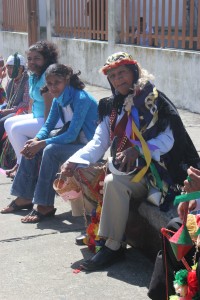
So, hijinks happen, and El Güegüense is both a hero and an anti-hero (one of his sons insists he’s an honest merchant, and the other says he’s shady). The plot is roughly about El G planning a wedding between one of the three ladies and his son, and somehow using this scenario to get away with not paying taxes to the Spaniards whom he hates. In format, it’s basically a typical musical, with songs and dances alternating between the spoken dialogue, and it all ends in a big party. But the subtext is about our (anti?)hero tricking the evil powers that be (this is also the subtext of every performance of Karagiozi shadow puppets which Greeks used to mock the Anatolian overlords back in the day).
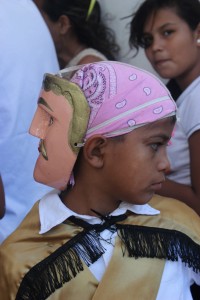
But the best part of the Gügüense is that it’s not only a play, musical, and dance revue, but everyone is wearing masks so it’s a kind of puppet show too (it’s a lot like if the Muppets and the Lion King and a savvy political satire had one big Nicaraguan ancestor).
So on the closing day of the week-long Güegüense/San Sebastian fest, all of these masked dancers, of varying ages, literally danced in to church after mass. First came a guy acting sort of like a bullfighter (or that’s what it looked like to me but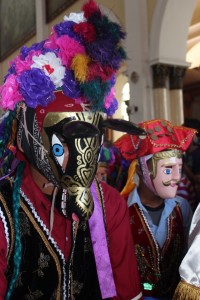 bear in mind I’m a honky who understands about 20% of what is going on at all times). Then came the masked Spaniards and locals, then their beasts of burdens who actually make donkey noises, then people dancing in local dress, and once Spaniards and locals and donkeys all cavorted up and down the aisles, the saints were ready to join the parade.
bear in mind I’m a honky who understands about 20% of what is going on at all times). Then came the masked Spaniards and locals, then their beasts of burdens who actually make donkey noises, then people dancing in local dress, and once Spaniards and locals and donkeys all cavorted up and down the aisles, the saints were ready to join the parade.
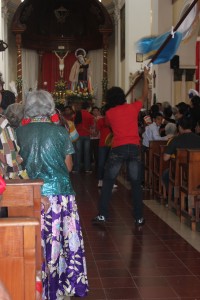 It’s been my experience that most religious celebrations bring in an element of physical risk. At Orthodox Easter, your hair may catch fire from all the candles around you. Pentecostals snake handle. Even Quakers quake. The danger at this ceremony was the risk of getting smacked in the head by the acrobatic flag-bearer preceding the statue of the saint; my ring did get caught in the fringe of Saint Anthony of Padua’s flag.
It’s been my experience that most religious celebrations bring in an element of physical risk. At Orthodox Easter, your hair may catch fire from all the candles around you. Pentecostals snake handle. Even Quakers quake. The danger at this ceremony was the risk of getting smacked in the head by the acrobatic flag-bearer preceding the statue of the saint; my ring did get caught in the fringe of Saint Anthony of Padua’s flag.
I traveled to Diriamba yesterday for the Güegüense but also for the saints. I had 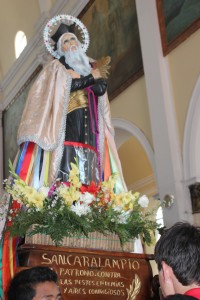 heard news this week that reminded me how fragile and overwhelming life can be and was feeling in particular need of divine intervention, both for myself and others. And Diriamba delivered. When I got there, I found what I love about churches everywhere–the mix of generations, everyone focused quietly on their inner thoughts, yet connected to each other at the same time. But I missed the incense and wanted to light a candle when I walked through the front door, like in an Orthodox church. I was longing for my spiritual home and then, during the parade of saints, I saw Saint Caralampio, whom I can only assume is the same Saint Charalambos the Miracle-Working who has a chapel at the border of the Greek mountain village where my father was born and I lived for a year. And I felt right at home again.
heard news this week that reminded me how fragile and overwhelming life can be and was feeling in particular need of divine intervention, both for myself and others. And Diriamba delivered. When I got there, I found what I love about churches everywhere–the mix of generations, everyone focused quietly on their inner thoughts, yet connected to each other at the same time. But I missed the incense and wanted to light a candle when I walked through the front door, like in an Orthodox church. I was longing for my spiritual home and then, during the parade of saints, I saw Saint Caralampio, whom I can only assume is the same Saint Charalambos the Miracle-Working who has a chapel at the border of the Greek mountain village where my father was born and I lived for a year. And I felt right at home again.
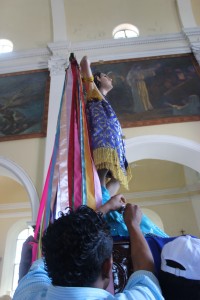 Swept up in the dancing and the pageantry, I bought a few milagros, metal charms that represent the miracle you’re hoping for, to offer Saint Sebastian, the patron saint of Diriamba and of my husband, whose middle name comes from the saint. My mother-in-law told me that we could give them to the men carrying the saint as they passed, and they would pin them to the saint, but that we had to be dancing the whole time they did so. (She told me she danced for a half hour in front of Santo Domingo a few years ago, praying that her son would get married. Nice work, Suegra!) The first saint-bearer looked at us like we were insane but then the handsome young man right after him took our milagros, slowed the procession, and pinned them onto Saint Sebastian who left the church under a shower of confetti tossed from the choir loft, his rainbow-colored ribbons rippling behind him.
Swept up in the dancing and the pageantry, I bought a few milagros, metal charms that represent the miracle you’re hoping for, to offer Saint Sebastian, the patron saint of Diriamba and of my husband, whose middle name comes from the saint. My mother-in-law told me that we could give them to the men carrying the saint as they passed, and they would pin them to the saint, but that we had to be dancing the whole time they did so. (She told me she danced for a half hour in front of Santo Domingo a few years ago, praying that her son would get married. Nice work, Suegra!) The first saint-bearer looked at us like we were insane but then the handsome young man right after him took our milagros, slowed the procession, and pinned them onto Saint Sebastian who left the church under a shower of confetti tossed from the choir loft, his rainbow-colored ribbons rippling behind him.
Church and dancing and folklore all serve to take us outside of ourselves while also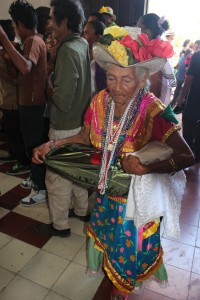 letting us be our most authentic. In church, we’re all praying for our own miracles, but when you look at the face of the supplicant opposite you, you realize that even though we all want different things, we’re the same by virtue of wanting, hoping, and praying for something so fervently. When you’re dancing, you’re doing something primal and universal, but no one moves exactly like you. And the folklore of a country reflects the preoccupations of people everywhere–how to survive under oppressive regimes, for example, or whom to marry–but in ways unique to that culture. Despite all the commonalities, I will go out on a limb and make a specific assertion: Yesterday was the best dance-party-slash-church-service I’ve ever attended. Thanks, Saints.
letting us be our most authentic. In church, we’re all praying for our own miracles, but when you look at the face of the supplicant opposite you, you realize that even though we all want different things, we’re the same by virtue of wanting, hoping, and praying for something so fervently. When you’re dancing, you’re doing something primal and universal, but no one moves exactly like you. And the folklore of a country reflects the preoccupations of people everywhere–how to survive under oppressive regimes, for example, or whom to marry–but in ways unique to that culture. Despite all the commonalities, I will go out on a limb and make a specific assertion: Yesterday was the best dance-party-slash-church-service I’ve ever attended. Thanks, Saints.